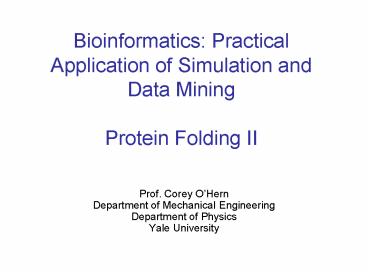Bioinformatics: Practical Application of Simulation and Data Mining Protein Folding II - PowerPoint PPT Presentation
Title:
Bioinformatics: Practical Application of Simulation and Data Mining Protein Folding II
Description:
Protein Folding II Prof. Corey O Hern Department of Mechanical Engineering Department of Physics Yale University Bioinformatics: Practical Application of Simulation ... – PowerPoint PPT presentation
Number of Views:150
Avg rating:3.0/5.0
Title: Bioinformatics: Practical Application of Simulation and Data Mining Protein Folding II
1
Bioinformatics Practical Application of
Simulation and Data MiningProtein Folding II
- Prof. Corey OHern
- Department of Mechanical Engineering
- Department of Physics
- Yale University
2
What did we learn about proteins?
- Many degrees of freedom exponentially growing
of - energy minima/structures
- Folding is process of exploring energy landscape
to - find global energy minimum
- Need to identify pathways in energy landscape
of - pathways grows exponentially with of structures
- Coarse-graining/clumping required
energy minimum
transition
- Transitions are temperature dependent
3
Coarse-grained (continuum, implicit solvent, C?)
models for proteins
J. D. Honeycutt and D. Thirumalai, The nature of
folded states of globular proteins, Biopolymers
32 (1992) 695.
T. Veitshans, D. Klimov, and D. Thirumalai,
Protein folding kinetics timescales, pathways
and energy landscapes in terms of
sequence-dependent properties, Folding Design
2 (1996)1.
4
3-letter C? model B9N3(LB)4N3B9N3(LB)5L
Bhydrophobic
Nneutral
Lhydrophilic
Number of sequences for Nm46
Nsequences 3 1022
Number of structures per sequence
Np exp(aNm)1019
5
and dynamics
different mapping?
6
Molecular Dynamics Equations of Motion
Coupled 2nd order Diff. Eq.
How are they coupled?
for i1,Natoms
7
(iv) Bond length potential
8
Pair Forces Lennard-Jones Interactions
i
j
Parallelogram rule
-dV/drij gt 0 repulsive -dV/drij lt 0 attractive
force on i due to j
9
Long-range interactions
BB
LL, LB
NB, NL, NN
V(r)
hard-core
attractions -dV/dr lt 0
r21/6?
r/?
10
Bond Angle Potential
?0105?
?ijk
k
i
j
?ijk0,?
11
Dihedral Angle Potential
Vd(?ijkl)
Successive Ns
Vd(?ijkl)
?ijkl
12
Bond Stretch Potential
for i, ji1, i-1
i
j
13
Equations of Motion
velocity verlet algorithm
Constant Energy vs. Constant Temperature
(velocity rescaling, Langevin/Nosé-Hoover
thermostats)
14
Collapsed Structure
T05?h fast quench (Rg/?)2 5.48
15
Native State
T0?h slow quench (Rg/?)2 7.78
16
(No Transcript)
17
start
end
18
Total Potential Energy
native states
19
Radius of Gyration
unfolded
Tf
native state
slow quench
20
2-letter C? model (BN3)3B
(1) Construct the backbone in 2D
N
B
(2) Assign sequence of hydrophobic (B) and
neutral (N) residues, B residues experience an
effective attraction. No bond bending
potential. (3) Evolve system under Langevin
dynamics at temperature T. (4) Collapse/folding
induced by decreasing temperature at rate r.
21
(No Transcript)
22
Energy Landscape
E/?C
E/?C
end-to-end distance
end-to-end distance
5 contacts
4 contacts
3 contacts
23
Rate Dependence
2 contacts
3 contacts
4 contacts
5 contacts
24
Misfolding
25
Reliable Folding at Low Rate
26
Slow rate
27
Fast rate
28
So far
- Uh-oh, proteins do not fold reliably
- Quench rates and potentials
Next
- ThermostatsYuck!
- More results on coarse-grained models
- Results for atomistic models
- Homework
- Next Lecture Protein Folding III (2/15/10)






























